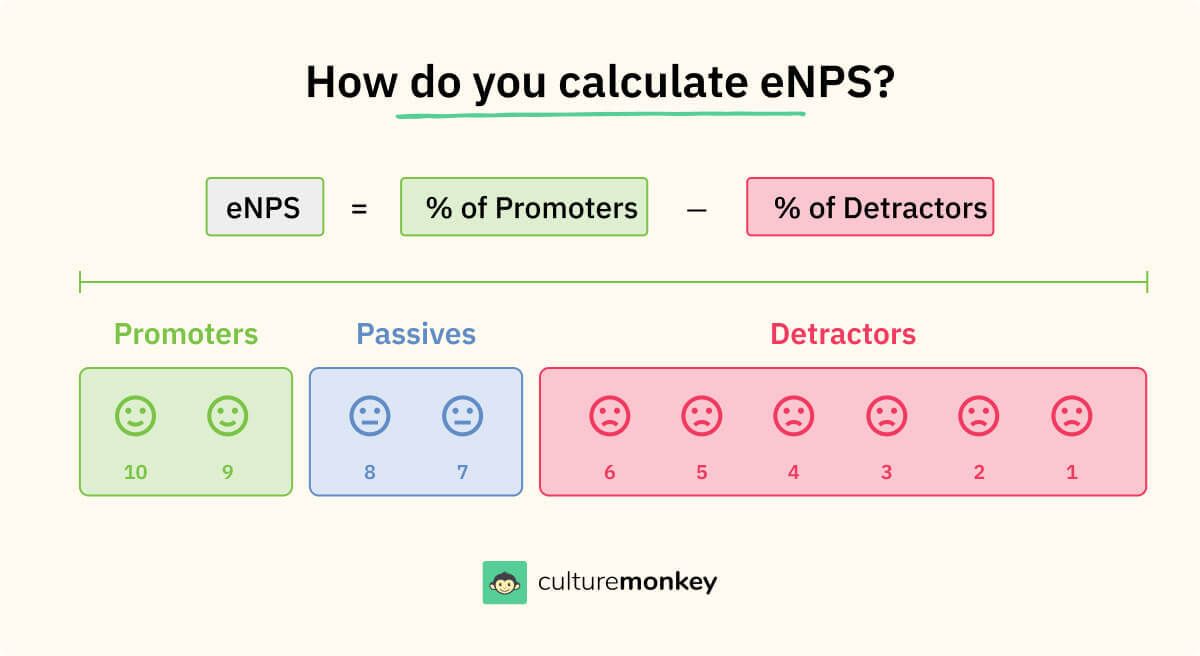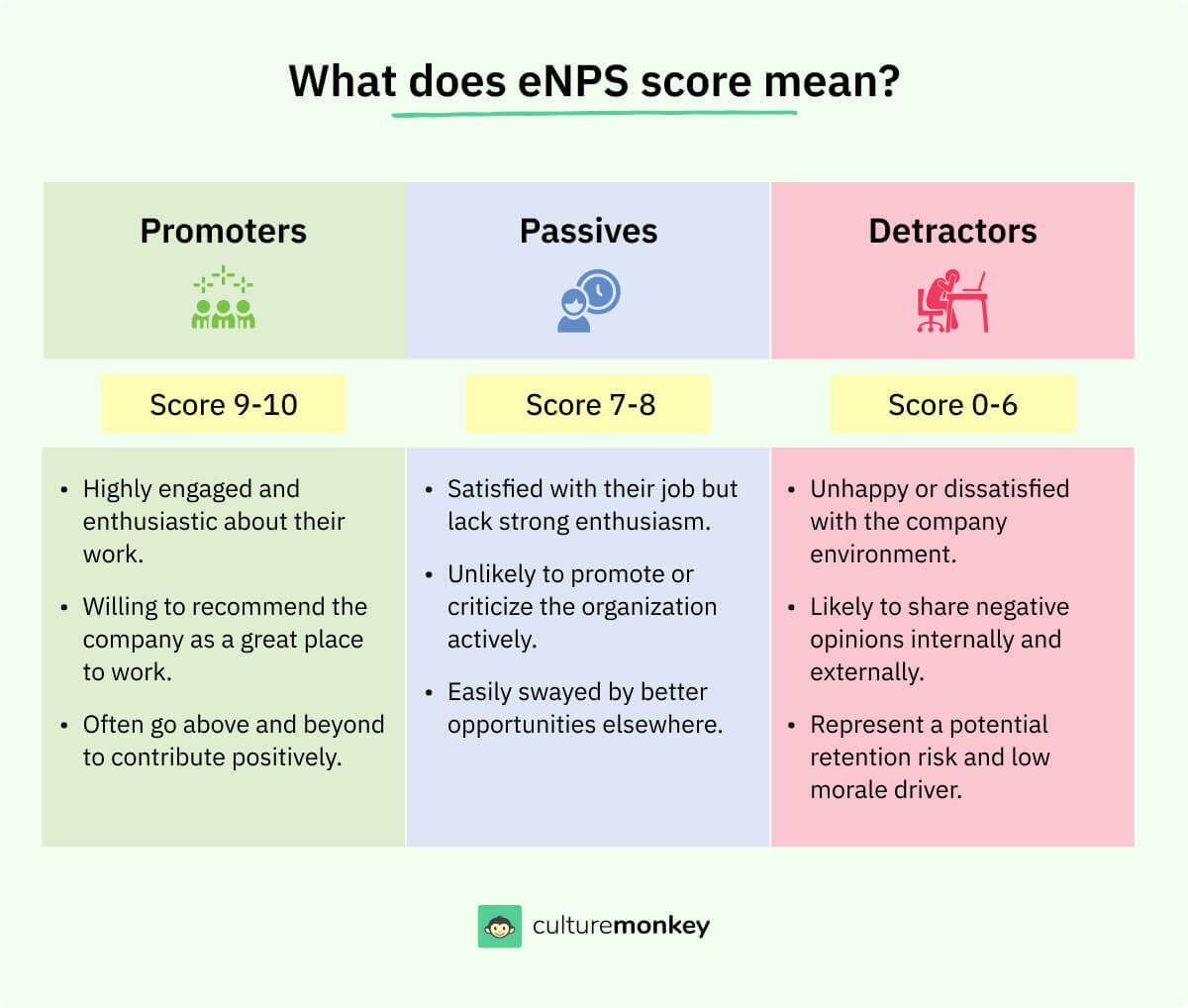What is eNPS (employee Net Promoter Score)?

Have you ever wondered how to measure employee engagement and satisfaction in a way that goes beyond just the surface level?
Enter eNPS, a powerful method to analyze employee feedback that allows you to tap into the hearts and minds of your employees and get a deeper understanding of their level of engagement and loyalty.
Blog Highlights


What is eNPS (employee Net Promoter Score)?
Employee Net Promoter Score (eNPS) is a method for measuring employee satisfaction and loyalty. It's based on the concept of Net Promoter Score (NPS), which is commonly used to measure customer loyalty.
One of the reasons why eNPS (employee Net Promoter Score) is so effective is that it allows you to identify not only the areas where your employees are satisfied but also the areas where they are dissatisfied. By understanding what drives employee engagement and loyalty, you can take concrete steps to improve your organization's culture and working environment.
And companies can increase productivity, reduce turnover, and build a more positive workplace culture by addressing issues and improving employee engagement.
Furthermore, eNPS goes beyond simple satisfaction surveys by classifying employees as Promoters, Passives, or Detractors. This classification provides HR and management with a clear picture of who the advocates are and who might be at risk of leaving.
By segmenting the workforce in this way, organizations can tailor their strategies to nurture Promoters, convert Passives into Promoters, and address the concerns of Detractors.
This targeted approach enhances the effectiveness of initiatives aimed at improving employee engagement and overall satisfaction, fostering a more harmonious and productive work environment.
But that’s not all of it, we highly recommend you keep reading so you might find everything you need to know about eNPS (employee Net Promoter Score) in this article.
The employee Net Promoter Score methodology
Let's demystify the Employee Net Promoter Score (eNPS) methodology, shall we? It's about understanding how likely your employees are to recommend your organization as a great workplace. Here's the lowdown.
- The question: eNPS hinges on a single question: "On a scale of 0 to 10, how likely are you to recommend this company as a great place to work?" It's simple yet powerful, measuring employee satisfaction and loyalty.
- Segmentation: Based on their responses, employees are categorized into three groups: Promoters (score 9-10), Passives (score 7-8), and Detractors (score 0-6).
- The math: The eNPS score is calculated by subtracting the percentage of Detractors from the percentage of Promoters. Passives are essentially neutral and don't factor into the equation.
- Interpretation: A high positive score (above 0) indicates that you have more Promoters than Detractors, which is great. A score above 50 is considered excellent, while anything below 0 suggests room for improvement.
- Continuous feedback: eNPS is typically collected periodically, allowing you to track changes over time. It's like taking your organization's temperature regularly, ensuring you catch any issues before they become major problems.
What are the benefits of eNPS?

Employee Net Promoter Score (eNPS) is a valuable metric that measures employee loyalty and advocacy towards an organization. Here are some of the benefits of eNPS:
Early warning system
eNPS provides an early warning system for HR leaders to identify potential issues and take corrective action. A declining eNPS indicates that employees are becoming less satisfied and may be at risk of leaving the company.
Cost-effective
eNPS (employee Net Promoter Score) is a cost-effective way to measure employee engagement and satisfaction compared to traditional employee surveys or pulse surveys. The eNPS survey is short and can be completed quickly by employees, saving time and resources.
Improves retention
eNPS helps HR leaders understand what motivates their employees and how to improve employee engagement. Organizations can improve employee retention rates and reduce turnover costs by addressing employee concerns.
Predicts business performance
eNPS has been shown to be a predictor of business performance. Companies with high employee net promoter scores tend to have better financial performance, higher customer satisfaction rates, and lower employee turnover rates.
Enhances customer experience
eNPS (employee Net Promoter Score) is not only an indicator of employee loyalty but also a driver of customer loyalty. Employees who are engaged and motivated are more likely to deliver exceptional customer service, which can lead to increased customer satisfaction and loyalty.
Improves employee morale
eNPS surveys provide a platform for employees to voice their opinions and feel heard. When employees feel valued and heard, it can boost morale and improve overall job satisfaction.
Benchmarking
eNPS can be used to benchmark against other companies in the same industry or geography. This allows organizations to identify improvement areas and track progress over time.
Easy to understand
eNPS (employee Net Promoter Score) is a straightforward metric that everyone in the organization can easily understand. This makes it an effective tool for communicating employee satisfaction to executives and other stakeholders.
Drives continuous improvement
eNPS surveys are conducted regularly, allowing organizations to track employee engagement changes over time. This data can be used to identify improvement areas and drive continuous improvement efforts.
Promotes employee engagement
By providing employees with a platform to voice their opinions and concerns, eNPS surveys promote employee engagement and participation. This can lead to a more collaborative and inclusive work environment where employees also feel valued and heard.
Enhances employee development
eNPS can highlight areas where employees may need additional support or training. By addressing these needs, organizations can foster employee growth and development, leading to a more skilled and adaptable workforce.
Strengthens employer brand
A high eNPS score is a testament to a positive workplace culture. This can be showcased in employer branding efforts, making it easier to attract top talent who are drawn to organizations where employees are genuinely satisfied and engaged.
Supports diversity and inclusion
eNPS surveys encourage diverse voices to be heard, providing valuable insights into the experiences of different demographic groups within the organization. This data can inform diversity and inclusion initiatives, ensuring that all employees feel included and valued.
Enhances innovation
Engaged employees are more likely to contribute innovative ideas. A high eNPS score indicates a workforce that is motivated and empowered to think creatively, fostering a culture of innovation and continuous improvement.
Drives employee advocacy
Promoters within the organization, those who give high eNPS scores, can become enthusiastic advocates both internally and externally. They can promote the company as a great place to work, contributing to a positive reputation and helping with talent acquisition efforts.
Is eNPS the ultimate measure?
Is eNPS (Employee Net Promoter Score) the ultimate measure of employee satisfaction and engagement? Well, it's a bit like asking if pizza is the ultimate food – it depends on your taste and what you're craving.
eNPS is undoubtedly a valuable tool, providing a snapshot of employee sentiment. However, it's not the end-all, be-all solution. Much like how a single ingredient doesn't make a gourmet dish, eNPS alone can't capture the complexity of employee experiences.
To truly gauge the pulse of your organization, you need a mix of measures. Surveys, feedback sessions, one-on-one conversations, and other metrics like turnover rates and productivity data are like different spices in your HR kitchen. They all contribute to the flavor of your employee engagement strategy.
So, while eNPS offers valuable insights, it's most effective when combined with a buffet of other methods. It's like building a well-rounded, satisfying meal – each element complements the others, creating a holistic picture of your employee experience. So, don't rely solely on eNPS; use it as one ingredient in your recipe for a thriving workplace.
What is the difference between NPS and eNPS?

Net Promoter Score (NPS) and Employee Net Promoter Score (eNPS) are two metrics used to measure customer and employee loyalty, respectively. While they share some similarities, the two have some key differences.
Here are some of the main differences between NPS and eNPS:
| Aspect | NPS (Net Promoter Score) | eNPS (Employee Net Promoter Score) |
|---|---|---|
| Target Audience | Measures customer loyalty. | Measures employee loyalty. |
| Survey Questions | Asks customers how likely they are to recommend a company to a friend or colleague. | Asks employees how likely they are to recommend their employer as a place to work. |
| Scoring System | Ranges from -100 to +100; calculated by subtracting the percentage of detractors from the percentage of promoters. | Ranges from -100 to +100; calculated similarly but also considers passive respondents. |
| Frequency of Surveys | Typically conducted on a regular basis (e.g., quarterly or annually). | Conducted regularly but may be more frequent (e.g., monthly or bi-annually). |
| Purpose | Measures customer loyalty and identifies improvement areas. | Measures employee loyalty, identifies areas for improvement, and enhances employee engagement. |
Why are some critical of eNPS?
Employee Net Promoter Score (eNPS) is widely used for gauging employee satisfaction and engagement, often with a simple question: “On a scale of 0 to 10, how likely are you to recommend this company as a great place to work?” Despite its popularity, eNPS has faced some criticism due to its limitations. Here are the key concerns raised by critics:
- Oversimplification of employee sentiments: eNPS reduces complex employee emotions and engagement levels to a single score, missing out on the nuances and deeper issues that influence workplace dynamics.
- Lack of actionable insights: While eNPS highlights satisfaction trends, it often fails to provide the detailed, actionable insights organizations need to address underlying issues and create targeted improvement strategies.
- Insufficient contextual information: The metric offers limited context without qualitative data, making it difficult for leaders to understand why employees feel a certain way and what specific changes may be necessary.
- Potential for misinterpretation: Factors such as timing, survey design, and biases can influence eNPS results, leading to possible misinterpretations that may not accurately reflect employee sentiment.
- Limited applicability: While useful for broad overviews, eNPS may not be suitable for all industries or situations and often needs to be supplemented with other engagement tools for a comprehensive understanding.
What are the limitations of eNPS, and how to overcome them?

While eNPS (employee Net Promoter Score) is a valuable tool, it is not without its limitations. Here are some of the limitations of eNPS and how to overcome them.
Limited scope
One of the limitations of eNPS (employee Net Promoter Score) is its limited scope. eNPS only measures employee loyalty and engagement but does not provide insight into other aspects of employee experience, such as work environment, career growth opportunities, and job satisfaction.
Solution: To overcome this limitation, companies should consider using regular employee engagement surveys, including employee lifecycle surveys, pulse surveys, and more, that focus on these other aspects of employee experience. By combining multiple surveys, companies can gain a more comprehensive understanding of employee experience and identify areas for improvement.
Limited actionability
While eNPS (employee Net Promoter Score) can provide valuable insights into employee loyalty and engagement, it does not provide actionable recommendations for improvement.
Solution: To overcome this limitation, companies should ensure that eNPS surveys are designed to collect open-ended feedback from employees. This feedback can then be analyzed and used to identify specific areas for improvement.
Limited accuracy
The accuracy of employee net promoter scores can be affected by factors such as response bias, sample size, and timing of the survey. For example, if only a small percentage of employees respond to the survey, the results may not be representative of the entire employee population.
Solution: Companies should ensure that eNPS surveys are designed to minimize response bias and increase response rates. This can be achieved by ensuring that the survey is easy to understand and complete and incentivizing employees to participate.
Additionally, companies should ensure that eNPS (employee Net Promoter Score) surveys are conducted at regular intervals to ensure that the results are representative of the entire employee population.
Lack of contextual information
eNPS (employee Net Promoter Score) only provides a numerical score without any contextual information. This means that companies may be unable to identify the factors driving employee engagement or disengagement.
Solution: Companies should consider using eNPS surveys in conjunction with other surveys that provide more contextual information. For example, companies could conduct pulse surveys to gather additional feedback from employees on specific topics, such as work-life balance or leadership effectiveness.
Cultural differences
eNPS surveys may not be effective in all cultures or regions. Different cultures may have different expectations and perceptions of loyalty and engagement, which can impact the effectiveness of the survey.
Solution: To overcome this limitation, companies should consider adapting their eNPS surveys to be culturally sensitive and relevant. This can be achieved by working with local HR teams or consultants to ensure that the employee Net Promoter Score questions are appropriate and applicable to the specific cultural context.
How do you calculate eNPS?

Calculating eNPS (employee Net Promoter Score) is a straightforward process that involves a simple survey. To calculate eNPS, companies typically ask employees to rate on a scale of 0-10 how likely they are to recommend their company as a place to work to friends or colleagues.
Based on the responses, employees are classified into three categories:
- Promoters (score 9-10): These are employees who are highly engaged and loyal to the company.
- Passives (score 7-8): These are employees who are neutral about the company.
- Detractors (score 0-6): These are employees who are unhappy or dissatisfied with the company.
To calculate the eNPS score, companies subtract the percentage of detractors from the percentage of promoters. The resulting score can range from -100 to 100, with higher scores indicating higher employee loyalty and engagement levels.
For example, if 40% of employees are promoters, 30% are passives, and 30% are detractors, the eNPS score would be 10 (40% - 30%). It's important to note that eNPS is a directional metric. Companies should use it as a starting point to identify areas for improvement and take action based on employee feedback.
What does eNPS score mean?

The eNPS (employee Net Promoter Score) is derived from a survey question that asks employees how likely they are to recommend their company as a place to work to friends or colleagues. The score is calculated based on the responses of three categories of employees: Promoters, Passives, and Detractors.
Promoters
Promoters are employees who score 9 or 10 on the eNPS survey question. These are highly engaged employees and loyal to the company, and are likely to recommend the company to others. They are a valuable asset to the company and can help to drive positive word-of-mouth marketing and referrals.
Passives
Passives are employees who score 7 or 8 on the eNPS survey question. These employees are neutral about the company and may be satisfied with their job but are not highly engaged or loyal. They are not likely to actively promote the company, but they are also not likely to speak negatively about it.
Detractors
Detractors are employees who score 0-6 on the eNPS survey question. These employees are unhappy or dissatisfied with the company, and may be actively disengaged or looking for other job opportunities. They can have a negative impact on the company's reputation and employee morale.
The resulting score can range from -100 to 100, providing companies with a quick and easy way to measure employee engagement and identify areas for improvement.
Why should HR leaders care about eNPS?

Picture this: You're at the helm of an organization, navigating the complex seas of human resources. Employee satisfaction, engagement, and retention are the compass guiding your ship. In this voyage, eNPS (Employee Net Promoter Score) is your North Star, and here's why HR leaders should care deeply about it.
Pulse on employee sentiment
eNPS is like an emotional barometer for your workforce. It tells you how your employees feel about the organization. By regularly measuring eNPS, HR leaders gain a real-time understanding of the employee sentiment landscape, helping them to navigate through calm waters and turbulent times.
A diagnostic tool
Think of eNPS as a diagnostic tool for your organization's health. It's like an annual check-up at the doctor's office. High eNPS scores indicate a healthy, engaged workforce, while low scores might signal underlying issues. HR leaders can use these insights to pinpoint areas that need attention and prescribe the right remedies.
Employee retention magic
HR leaders know that retaining top talent is paramount. Well, eNPS is a magician in this regard. High eNPS scores are often linked to lower turnover rates. When employees feel valued and engaged, they're more likely to stay onboard, reducing recruitment and training costs.
Recruitment magnet
It's no secret that organizations with stellar eNPS scores become magnets for top talent. When your employees become your brand ambassadors, speaking highly of their workplace, it's like a siren call to potential hires. HR leaders can leverage eNPS to attract the best and brightest.
Enhancing company culture
HR leaders are the guardians of company's culture. eNPS is a litmus test for culture – it reflects whether the culture is nurturing, inclusive, and empowering or whether it needs an overhaul. By understanding what drives high eNPS scores, HR can shape a culture that employees love.
Engagement boost
Engaged employees are more productive, creative, and motivated. eNPS provides insights into the factors that drive engagement. HR leaders can use this data to craft strategies that boost engagement, leading to improved performance and profitability.
Competitive advantage
In today's competitive business landscape, organizations need every advantage they can get. eNPS can be a game-changer, setting your organization apart from the competition. HR leaders who harness eNPS effectively gain a strategic edge in talent management.



Always treat your employees exactly as you want them to treat your best customers.
Global Practice Leader
FranklinCovey
eNPS benchmarks

Now that you have measured the eNPS scores, how do you know if the score you’ve got is good or bad?
eNPS (employee Net Promoter Score) benchmarks solves just that as they are useful for companies to measure and compare their employee engagement levels against industry standards. Here are some key pointers to keep in mind:
- eNPS scores vary by industry: Different industries may have different benchmarks for eNPS scores. For example, tech companies may have higher eNPS scores due to the nature of their work and company culture, while healthcare companies may have lower scores due to factors such as long working hours and high-stress levels.
- Regional differences: eNPS scores can also vary by region or country. For example, companies in the US may have higher eNPS scores than those in Europe or Asia due to cultural differences in the workplace.
- Use industry-specific benchmarks: It's important to use industry-specific benchmarks when comparing eNPS scores. This can help companies understand how they are performing relative to their peers and identify areas for improvement.
- Benchmark against competitors: Companies can also benchmark their eNPS scores against their competitors to better understand their market position and identify opportunities to differentiate themselves in terms of employee engagement.
- Company size matters: The size of a company can also impact eNPS benchmarks. Small companies may have higher eNPS scores due to closer relationships between employees and management, while larger companies may have more diverse employee populations and lower scores.
- Look at trends over time: eNPS scores can vary over time, so it's important to track trends and changes in scores by continuously listening to your employees leveraging employee survey templates. This can help companies identify areas where they have improved or declined and take action accordingly.
- Consider external factors: It's important to consider external factors that may impact eNPS scores, such as changes in the economy, company leadership, or industry trends. These factors may impact the benchmark for eNPS scores and should be taken into account when interpreting results.
- Employee demographics: The demographics of an organization's workforce can influence eNPS benchmarks. For instance, companies with a younger workforce might have different eNPS score expectations compared to those with a more diverse age range.
- Company life cycle: The stage of a company's lifecycle can affect eNPS scores. Startups and newly established firms may experience higher eNPS scores as they often have a sense of excitement and innovation. In contrast, more mature companies might have established routines and potentially lower scores.
- Industry disruptions: Rapid changes and disruptions within an industry can impact eNPS benchmarks. Organizations operating in industries facing significant disruptions may experience fluctuating scores as employees navigate uncertainties and changes.
- Remote work trends: With the rise of remote work, eNPS scores can be influenced by how well companies adapt to this shift. Organizations that effectively support remote work may see higher scores, while those struggling with the transition might face challenges in maintaining employee engagement levels.
Employee Net Promoter score by industry
The eNPS (Employee Net Promoter Score) offers valuable benchmarks for assessing employee loyalty and satisfaction within specific sectors. These scores vary widely, reflecting unique challenges, cultures, and expectations within each industry. Here’s a look at eNPS benchmarks across key sectors and what these scores mean for your organization.
eNPS benchmark for consulting industry
The consulting industry leads with an impressive score of 68, reflecting high levels of engagement driven by competitive benefits, growth opportunities, and team collaboration. This benchmark highlights the sector's strong emphasis on career progression and rewarding work culture. However, high performance expectations can create pressure, making continuous engagement initiatives essential.
eNPS benchmark for insurance industry
Insurance scores highest at 71, indicating a strong focus on employee engagement through comprehensive benefits, stability, and development programs. This industry often sees higher retention due to a focus on career paths and supportive policies. However, evolving regulations and workload can be sources of stress that companies must manage.
eNPS benchmark for technology & services industry
With a score of 61, technology & services sectors show a strong emphasis on innovation, flexibility, and professional growth, making it attractive for employees. The rapid pace of change demands regular engagement to keep teams motivated. Balancing innovation with stability remains a challenge to retaining top talent.
eNPS benchmark for e-commerce industry
Scoring 62, e-commerce reflects a blend of dynamic work environments and high adaptability. The sector offers flexibility and exciting growth opportunities, engaging its workforce effectively. The fast-paced nature of the industry can lead to burnout, emphasizing the need for robust employee support systems.
eNPS benchmark for retail industry
Retail’s score of 61 demonstrates efforts to enhance employee experiences through training, incentives, and supportive environments. Despite challenges like high turnover, retail organizations are finding ways to increase engagement. Listening to frontline feedback and offering development opportunities can further improve satisfaction.
eNPS benchmark for construction industry
With an eNPS of 45, construction has room for improvement but shows potential. Factors like safety concerns, project demands, and field conditions contribute to engagement variability. Companies prioritizing safety, training, and growth paths can significantly impact their workforce’s loyalty.
eNPS benchmark for logistics & transportation industry
Logistics & transportation scores 43, indicating challenges such as high operational demands and labor intensity. Employee engagement efforts focusing on safety, wellness, and recognition are crucial in this sector. Companies that support work-life balance and offer career progression see higher retention rates.
What are average Employee Net Promoter Scores?
The average Employee Net Promoter Score (eNPS) can differ widely based on industry, region, and a company’s internal culture. Understanding these averages offers valuable insights into how well your workforce is engaged compared to peers and global norms.
Global average:
The global average for eNPS generally ranges from +10 to +20. This indicates a moderately positive level of employee sentiment but also reflects opportunities for improvement. Companies scoring within this range often have a mixed level of engagement, suggesting areas for further employee support and enhancement.
Regional differences:
Regional disparities in eNPS scores can be influenced by cultural norms, workplace practices, and labor laws. For example, scores in North America may trend differently compared to those in Europe or Asia, reflecting distinct engagement drivers and expectations. Organizations should consider these regional nuances when interpreting their eNPS data.
Company size :
Large organizations tend to exhibit a broader range of eNPS scores due to variations across departments and unique employee experiences. In contrast, smaller companies often see more consistency, as leadership engagement and culture may be more uniformly felt.
These averages and trends serve as a benchmark, offering a starting point for organizations to assess their own scores. However, it’s critical to contextualize these averages based on industry-specific norms and internal historical data to derive the most meaningful insights into employee engagement.
Regular comparisons with past performance and industry standards help to create positive experiences in the workplace for the employees.
What is a good eNPS score?

Generally, the eNPS score ranges from -100 to +100. A score of 0 indicates that the number of detractors and promoters is equal. A score above zero suggests that you have more promoters than detractors, while a negative score implies that you have more detractors than promoters.
The following is a general guide to interpreting eNPS scores:
- A score between 50-100 is considered excellent, indicating that most employees are happy and satisfied with their jobs.
- A score between 30-50 is considered good, indicating that most employees are happy, but some issues may need to be addressed.
- A score between 0-30 is considered average, indicating that some employees are satisfied, but there may be significant room for improvement.
- A score of 0 is considered poor, indicating that many employees are dissatisfied with their jobs and significant issues must be addressed.
eNPS calculation examples:
Calculating eNPS (employee Net Promoter Score) involves asking employees questions similar to: "On a scale of 0-10, how likely are you to recommend our company as a place to work?" Based on the employees' responses, they are categorized into three groups:
- Promoters: Those who rate the company 9-10.
- Passives: Those who rate the company 7-8.
- Detractors: Those who rate the company 0-6.
The eNPS (employee Net Promoter Score) is then calculated by subtracting the percentage of detractors from the percentage of promoters. Here are some examples:
Example 1: Positive
- Promoters: 65%
- Passives: 20%
- Detractors: 15%
eNPS: 50 (65%-15%)
Example 2: Neutral
- Promoters: 40%
- Passives: 30%
- Detractors: 30%
eNPS: 10 (40%-30%)
Example 3: Negative
- Promoters: 20%
- Passives: 40%
- Detractors: 40%
eNPS: -20 (20%-40%)
Example 4: A cause for concern
- Promoters: 15%
- Passives: 40%
- Detractors: 45%
eNPS: -30 (15%-45%)
In these (example 4 & 5) scenarios, the eNPS scores are in the negative range, indicating a significant portion of employees are dissatisfied or unengaged. A score like this should raise red flags for HR and leadership.
It's a clear signal that immediate action is needed to address employee concerns, improve workplace conditions, and boost morale. High turnover rates and a challenging work environment are common in organizations with such low eNPS scores.
While eNPS scores provide a numeric snapshot of employee sentiment, it's essential for organizations to go beyond the numbers. Employee well-being, job satisfaction, and engagement are holistic concepts influenced by various factors like leadership, workplace culture, benefits, and growth opportunities.
eNPS serves as a starting point, prompting organizations to delve deeper into these aspects to create a workplace where employees are not just satisfied but thriving and genuinely loyal.
How to structure your eNPS cycles?

Conducting eNPS surveys requires careful planning and structuring to generate useful insights. Here are some pointers to help you structure your eNPS cycles effectively:
Determine the frequency of your eNPS (employee Net Promoter Score) surveys
Decide on the frequency of conducting eNPS surveys based on the size of your organization, the nature of your work, and the overall engagement levels of your employees. Generally, conducting eNPS surveys bi-annually or annually is considered sufficient.
Choose the right timing
Timing is crucial while conducting eNPS surveys. Choose a time when your employees are not going through any significant changes or disruptions, such as organizational restructuring, layoffs, or management changes. Conducting employee engagement surveys during such times might affect the accuracy of the results.
Decide on the survey questions
Plan and design your eNPS survey questions carefully. The survey should be concise and straightforward, and the questions should be relevant to the employees. A standard eNPS question is: "On a scale of 0-10, how likely are you to recommend our organization as a place to work?" followed by follow-up questions asking for the reason behind the score.
Ensure anonymity
Employees must feel comfortable while sharing their feedback. Ensure that the surveys are anonymous and their responses are confidential. Anonymity in surveys helps employees to be assured that their feedback won't affect their employment status or career growth opportunities.
Communicate survey results and follow-up action
After the survey, communicate the results with the employees and let them know how the feedback will be used to improve the work culture. Ensure to take concrete steps based on the feedback received and communicate progress. This will help employees feel valued and heard, thereby increasing their engagement and loyalty towards the organization.
How to improve eNPS?

We know if you have come this far, you are indeed interested in measuring and improving your organizations' eNPS score. Although this is a tricky part, let’s see how you can manuever this and improve your eNPS scores -
Act on employee feedback
Encourage your employees to provide feedback, then take action on the feedback they provide. Address issues and concerns that your employees bring up and communicate your action plan to your team.
Improve employee engagement
Increase employee engagement by offering opportunities for career development, providing employee recognition for a job well done, and fostering a positive company culture.
Enhance communication
Enhance communication between employees and managers, and promote transparency in the workplace. Clear communication helps to build trust and strengthens relationships between team members.
Encourage teamwork
Create an environment that fosters teamwork, collaboration, and open communication. Encourage your employees to work together on projects and build a sense of camaraderie.
Increase employee recognition
Recognize and reward your employees for their hard work and achievements. It can be as simple as a thank-you email or as elaborate as an employee appreciation event.
Provide opportunities for learning and development
Offer training and development programs that help your employees to grow their skills and knowledge. Providing opportunities for professional growth can increase employee engagement and satisfaction.
Address work-life balance
Addressing work-life balance concerns and providing support to employees who are struggling to balance their work and personal life will encourage them to take breaks and provide flexible scheduling options when possible.
Focus on employee wellness
Prioritize employee wellness by providing wellness programs, promoting healthy habits, and providing mental health support. Employees who feel cared for and supported are more likely to be engaged and loyal to their company.
Implementing these strategies can create a positive work environment and improve your eNPS score. Remember, a high eNPS score is an indication of employee satisfaction and loyalty, which translates to better business and employee performance.
5 Follow-up questions you need on your eNPS survey
Following up on your eNPS survey results is crucial for obtaining deeper insights into employee sentiments. By asking the right questions for your follow up survey, you can uncover specific drivers behind employee satisfaction, areas that need attention, and actionable opportunities for improvement. Here are five essential follow-up questions to include in your eNPS survey:
What was the primary reason for the score you gave?
This open-ended question helps pinpoint the main factors influencing an employee’s rating. It provides context to their score and highlights what they value most or what may be causing dissatisfaction.
What changes would make this organization a better place to work?
Employees often have unique perspectives on what could enhance their work environment. This question invites constructive feedback on areas like company culture, leadership, or operational improvements
What is one thing that keeps you motivated to work here?
Understanding what keeps employees engaged can offer valuable insights into your organization’s strengths. It also helps to identify which aspects of your culture or benefits resonate most with your workforce.
If you could change one thing about your work experience here, what would it be?
This question encourages employees to prioritize their feedback and reveal their top concern, providing actionable data to HR and leadership teams.
Would anything hold you back from referring friends or colleagues to work here?
Referral hesitations can reveal underlying issues that might not surface in general feedback. Knowing what would prevent employees from promoting your workplace can guide initiatives to strengthen culture and trust.
Why ask an employee Net Promoter Score question?

Ever wondered why you should bother asking your employees the infamous Employee Net Promoter Score (eNPS) question? Well, that's a question worth exploring.
Unearth hidden insights
The eNPS question digs deeper than your typical employee survey. It's not just about measuring satisfaction; it uncovers the underlying sentiment. Are your employees so thrilled they'd shout your company's name from the rooftops, or are they secretly plotting an escape? It's a sentiment goldmine.
Identify areas for improvement
When you know where your employees stand on the "recommendation scale," you can pinpoint areas that need your attention. Maybe it's workplace culture, leadership, or work-life balance. The eNPS question acts like a compass guiding you towards areas in need of improvement.
Track progress over time
Asking the eNPS question periodically is like tracking your fitness journey. You can see if those efforts at the gym (or in the office) are paying off. Is your eNPS score on the rise? It's a sign you're moving in the right direction.
Measure overall employee loyalty
eNPS is a loyalty indicator. Promoters, those who give high scores, are your extremely loyal employees. They're more likely to stick around, give their best, and even refer top talent.
Make informed decisions
Armed with eNPS insights, you can make data-driven decisions. It's like having a GPS for navigating your organization's growth and success.
How often should you measure eNPS?

The frequency of eNPS measurement depends on the organization's needs and goals. However, measuring eNPS at least once a year is generally recommended to track the overall progress and identify trends in employee engagement.
Some companies may measure eNPS more frequently, such as every quarter or every six months, to stay on top of employee feedback and address any concerns or issues promptly. It's important to strike a balance between collecting enough data to make informed decisions and avoiding survey fatigue among employees.
Ultimately, the frequency of eNPS measurement should be determined by the company's resources, goals, and willingness to act on employee feedback.
How to use eNPS effectively?
Ah, the elusive art of using eNPS (Employee Net Promoter Score) effectively – it's like having a powerful tool in your hands, but knowing how to wield it is the real game-changer. Here's your roadmap to eNPS success.
- Ask the right questions: Start by crafting thoughtful, open-ended follow-up questions to your eNPS survey. Don't settle for just the numerical score. Dive deeper. Ask employees why they gave that score. Their comments can be gold mines of insights.
- Consistency is key: Make eNPS a regular practice, not just a one-time affair. Regular surveys, whether quarterly or annually, allow you to track employee engagement trends and measure progress over time.
- Analyze, don't just collect: Don't let those survey results gather digital dust. Analyze the data diligently. Look for patterns, trends, and common sentiments. This is where you unearth the gems that can drive positive change.
- Share and discuss: Transparency is your friend. Share the results with your team and discuss them openly. This fosters a culture of improvement and shows employees that their voices matter.
- Take action: The most crucial step! Use the feedback to make tangible improvements. Address pain points, celebrate successes, and communicate the changes made based on the feedback. Actions speak louder than surveys.
- Continuous feedback loop: Keep the conversation going. Regularly update employees on the progress made and ask for their input on ongoing initiatives. It's about building a culture of constant improvement.
- Don't forget to celebrate: When improvements lead to positive changes in eNPS scores, celebrate them. Recognition reinforces the idea that feedback leads to progress.
How can eNPS be used to increase engagement?

Employee engagement is critical to any organization's success, and measuring it can be challenging. Just measuring eNPS is not enough, and companies need to take action to increase engagement based on the results. Here are some ways in which eNPS can be used to increase engagement:
Identify key drivers of employee engagement
eNPS surveys can provide insights into what factors are driving employee engagement within an organization. These engagement drivers could be anything from work-life balance, management support, or growth opportunities. Once the key employee engagement drivers are identified, the organization can focus on improving those areas to increase engagement.
Use eNPS as a continuous feedback loop
eNPS is not just a one-time measurement. It should be treated as a continuous feedback loop, where the organization consistently seeks feedback from employees and acts on it. Regular eNPS surveys help identify any changes in employee engagement metrics, and organizations can take necessary actions to address any issues.
Celebrate successes
When employees give positive feedback through eNPS surveys, it is essential to celebrate those successes. Recognition and appreciation of employees' efforts can increase their motivation and engagement levels.
Address negative feedback
Negative feedback can be uncomfortable, but it is essential to address it to improve engagement. Organizations should communicate with employees about their plans to address negative feedback and keep them informed about the progress.
Involve employees in the improvement process
eNPS can be a valuable tool to involve employees in the improvement process. Organizations can collaborate with employees to identify improvement areas, develop solutions, and implement them. This process creates a sense of ownership and accountability, which can boost engagement levels.
eNPS can be an effective tool to measure and improve employee engagement. However, using the results to take action and create a culture of continuous feedback and improvement within the organization is crucial.
What about companies that use the single-question eNPS metric?
Ah, the single-question eNPS (Employee Net Promoter Score) metric – the one-question wonder that's both celebrated and critiqued in the world of employee engagement measurement. So, what's the deal with companies that swear by it?
For some organizations, simplicity is the name of the game. They argue that the single-question eNPS cuts through the noise, providing a straightforward way to gauge employee sentiment. It's like opting for a streamlined, no-frills menu at a restaurant – you know what you're getting, and there's no room for confusion.
Companies that use the single-question eNPS often do so because it's quick and easy to administer. It doesn't require employees to spend hours filling out surveys, which can lead to survey fatigue. It's like serving up a delicious fast-food meal – it's convenient and gets the job done.
However, here's the flip side: some critics argue that this single-question approach lacks depth. It's like judging a book solely by its cover. You get a score, but you miss out on the "why" behind it. Without follow-up questions or qualitative data, it's challenging to pinpoint the root causes of high or low scores.
In the end, it really boils down to the specific needs and culture of the company. For some, the single-question eNPS metric is the perfect fit – a quick, no-nonsense way to keep a finger on the pulse.
For others, a more comprehensive approach, blending quantitative and qualitative data, is the preferred recipe for understanding and improving the employee experience. It's like choosing between a quick snack or a full-course meal – both have their merits, depending on your appetite and goals.
Things to keep in mind about employee net promoter score

Here are some key things to keep in mind about employee Net Promoter Score (eNPS):
- Confidentiality: Employee feedback is personal and confidential, and it is important to communicate this to employees. Ensure that the feedback is collected anonymously to build trust and encourage honesty.
- Timing: The timing of the eNPS survey is crucial to its success. The survey should be conducted at a time when employees are most engaged and motivated. Conducting the survey during a busy period may result in low participation and inaccurate feedback.
- Continuous improvement: eNPS is an ongoing process and should be used as a continuous feedback loop to improve workplace engagement and employee experience over time. Continuously monitor progress and make improvements as needed.
- eNPS is not a one-time event: eNPS surveys must be conducted regularly to track employee satisfaction and engagement over time. Establishing a regular cadence for employee surveys and communicating to employees when they can expect to receive them is important.
- eNPS is only one tool for measuring engagement: While eNPS can be valuable for assessing employee engagement, it's not the only tool available. It's important to consider other metrics, such as employee satisfaction surveys, turnover rates, and absenteeism, to get a complete picture of employee engagement.
- eNPS is most effective when coupled with action: Simply measuring eNPS scores won't do much to improve engagement unless action is taken based on the results. Employers should be prepared to analyze the results, identify areas for improvement, and take concrete steps to address any issues that are identified.
- eNPS varies: eNPS scores can vary based on the industry and the specific company culture. It's important to understand what a "good" eNPS score means for your organization and how it compares to others in your industry. Benchmarks can be helpful, but they should be viewed as guidelines rather than strict rules.
- Not the only source: eNPS should not be the sole measure of employee engagement or satisfaction. It is just one tool among many that can help organizations understand their workforce. It's important to use eNPS in conjunction with other measures, such as employee satisfaction surveys, mental health surveys, manager effectiveness surveys, employee lifecycle surveys.
How to integrate eNPS with other employee feedback systems
Integrating eNPS (Employee Net Promoter Score) with other employee feedback systems can provide a more holistic view of employee engagement and satisfaction. While eNPS offers a quick snapshot of loyalty and sentiment, combining it with other tools can enhance its impact. Here’s how to make it work effectively:
Combine eNPS with pulse surveys
Supplement your periodic eNPS scores with shorter, frequent pulse surveys. This allows for a continuous check-in on specific issues, providing context to eNPS trends and enabling quicker responses to employee concerns.
Link with employee lifecycle surveys
Integrating eNPS with surveys conducted at key stages of the employee lifecycle—such as onboarding, exit, and performance milestones—can reveal how engagement evolves over time. This gives valuable insights into areas needing attention at different career stages.
Qualitative feedback channels
Use open-ended questions, focus groups, and one-on-one meetings alongside eNPS to gather qualitative data. This helps uncover the “why” behind scores, offering deeper, actionable insights.
Incorporate manager feedback mechanisms
Managers play a key role in engagement. Integrate eNPS results with feedback collected from manager effectiveness surveys to align leadership development efforts with engagement goals.
Data-driven dashboards
Create centralized dashboards that combine eNPS data with other key engagement metrics like retention rates, productivity, and employee satisfaction scores. This makes it easier to track trends, correlations, and measure the impact of initiatives over time.
Tie feedback to action plans
Use the combined insights from eNPS and other feedback systems to build targeted action plans, ensuring employees see tangible improvements based on their input. This helps foster a culture of trust and continuous improvement.
How do you use eNPS ft. CultureMonkey, to enhance your employee experience through eNPS
It is important to keep in mind that eNPS is not a one-time solution but an ongoing process that requires continuous monitoring and feedback. Companies should create a structured and consistent approach to eNPS surveys to ensure they capture the right data and insights effectively.
When using eNPS, it is important to consider the factors influencing employee responses, such as communication, leadership, and company culture. Companies should also strive to ensure that the eNPS survey is easy to understand and accessible to all employees.
By using a platform like CultureMonkey, companies can easily collect and analyze their eNPS data, gain valuable insights, and take action to improve their scores.
With features such as real-time employee feedback analytics, customizable surveys, and automated reporting, CultureMonkey can help companies to streamline their eNPS cycles and optimize their engagement strategies. By prioritizing employee feedback and taking steps to create a positive workplace culture, companies can improve their eNPS scores and drive greater business success and growth.
Summary
Employee Net Promoter Score (eNPS) is a key metric for measuring employee satisfaction and loyalty, based on a single survey question that categorizes responses into Promoters, Passives, and Detractors. By understanding employee sentiment and addressing areas of dissatisfaction, organizations can enhance engagement, reduce turnover, and boost productivity. While eNPS provides valuable insights, it works best when combined with other feedback methods for a holistic employee experience strategy.
FAQs
What is employee Net Promoter Score (eNPS)?
Employee Net Promoter Score (eNPS) is a metric used to measure employee satisfaction and loyalty within an organization. It is based on a single question: "On a scale of 0 to 10, how likely are you to recommend this company as a great workplace?" Employees are categorized as Promoters (score 9-10), Passives (score 7-8), or Detractors (score 0-6).
How to calculate eNPS for my organization?
To calculate eNPS, first, survey your employees using the eNPS question. Then, determine the percentage of Promoters and Detractors among the respondents. Finally, subtract the percentage of Detractors from the percentage of Promoters. The resulting score can range from -100 to 100, with higher scores indicating a more positive employee sentiment.
Why is eNPS important for employee engagement?
Employee Net Promoter Score (eNPS) is crucial for employee engagement because it serves as a key indicator of how connected and satisfied employees are with their organization. Engaged employees tend to be Promoters, those who give high eNPS scores, indicating they would recommend their workplace. Tracking eNPS provides HR insights into the effectiveness of their engagement efforts.
What are the benefits of using eNPS in HR?
The use of eNPS in HR comes with numerous advantages. It offers real-time feedback, helping HR teams stay attuned to employee sentiment. By identifying Promoters and Detractors, organizations can develop targeted strategies to enhance workplace satisfaction and loyalty. eNPS also aids in tracking changes over time, allowing HR to measure the impact of their initiatives.
Can eNPS help reduce employee turnover?
Yes, eNPS can play a significant role in reducing employee turnover. When employees are engaged, satisfied, and classified as Promoters in eNPS surveys, they are more likely to remain with the organization. High eNPS scores often indicate a positive workplace culture, where employees feel valued and connected to their jobs. This sense of loyalty and contentment translates into increased employee retention.
What are some best practices for implementing eNPS surveys?
Best practices for implementing eNPS surveys include keeping the survey short and simple, ensuring anonymity, conducting surveys regularly, analyzing and acting on the feedback, and involving employees in the process to improve response rates and engagement.
Are there any alternatives to eNPS for measuring employee satisfaction?
Yes, there are alternatives to eNPS, such as employee satisfaction surveys, employee engagement surveys, and pulse surveys. These methods often include a broader range of questions and provide more comprehensive insights into employee satisfaction and engagement. Organizations may choose the method that best aligns with their specific goals and needs.




